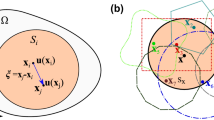Abstract
The Arlequin framework proposed by Ben Dhia in 1998 is a flexible and robust method for conducting global/local analysis of structures and materials. A penalty version of the Arlequin framework for the study of structural problems involving large deformation is considered here. The implementation of the penalty-based Arlequin framework into ABAQUS is then explored and the corresponding Arlequin user element subroutine is developed. Geometric nonlinear simulations of a cantilever beam and a shallow arch are conducted and the choice of the coupling operator with an appropriate penalty parameter is studied. The numerical results justify the feasibility of the proposed method, ensuring its further application to more complicated problems involving geometric or material nonlinearities.
Similar content being viewed by others
References
Bathe, K.J., 1996. Finite Element Procedures. Prentice Hall, USA.
Ben Dhia, H., 1998. Multiscale mechanical problems: the Arlequin method. Comptes Rendus de l’Académie des Sciences-Series IIB-Mechanics-Physics-Astronomy, 326(12):899–904 (in French). [doi:10.1016/S1251-8069(99)80046-5]
Ben Dhia, H., 2008. Further insights by theoretical investigations of the multi-scale Arlequin method. International Journal for Multiscale Computational Engineering, 6(3): 215–232. [doi:10.1615/IntJMultCompEng.v6.i3.30]
Ben Dhia, H., Rateau, G., 2001. Analyse mathématique de la méthode arlequin mixte. Comptes Rendus de l’Académie des Sciences-Series I-Mathematics, 332(7):649–654 (in French). [doi:10.1016/S0764-4442(01)01900-0]
Ben Dhia, H., Zammali, C., 2004. Level-sets and Arlequin framework for dynamic contact problems. Finite Elements European Review, 5–7(13):403–414.
Ben Dhia, H., Rateau, G., 2005. The Arlequin method as a flexible engineering design tool. International Journal for Numerical Methods in Engineering, 62(11):1442–1462. [doi:10.1002/nme.1229]
Chandrupatla, T.R., Belegundu, A.D., 1991. Introduction to Finite Elements in Engineering. Prentice-Hall, USA.
Fish, J., 1992. The s-version of the finite element method. Computers and Structures, 43(3):539–547. [doi:10.1016/0045-7949(92)90287-A]
Guidault, P.A., Belytschko, T., 2007. On the L 2 and the H 1 couplings for an overlapping domain decomposition method using Lagrange multipliers. International Journal for Numerical Methods in Engineering, 70(3):322–350. [doi:10.1002/nme.1882]
Hu, H., Belouettar, S., Potier-Ferry, M., Daya, E.M., 2008. Multi-scale modelling of sandwich structures using the Arlequin method Part I: linear modelling. Finite Elements in Analysis and Design, 45(1):37–51. [doi:10.1016/j.finel.2008.07.003]
Hu, H., Belouettar, S., Potier-Ferry, M., Daya, E.M., Makradi, A., 2010. Multi-scale nonlinear modelling of sandwich structures using the Arlequin method. Composite Structures, 92(2):515–522. [doi:10.1016/j.compstruct.2009.08.051]
Hughes, T.J.R., 1995. Multiscale phenomena: Green’s functions, the Dirichlet-to-Neumann formulation, subgrid scale models, bubbles and the origins of stabilized methods. Computer Methods in Applied Mechanics and Engineering, 127(1–4):387–401. [doi:10.1016/0045-7825(95)00844-9]
Qiao, H., Chen, W.Q., Zhang, C.Z., 2010. Dynamic Multiscale Analysis of Structures via the ARLEQUIN Method. Proceedings of the 1st International Conference on Advances in Interaction and Multiscale Mechanics, Jeju, Korea.
Qiao, H., Yang, Q.D., Chen, W.Q., Zhang, C.Z., 2011. Implementation of the Arlequin method into ABAQUS: basic formulations and applications. Advances in Engineering Software, 42(4):197–207. [doi:10.1016/j.advengsoft.2011.02.005]
Rannou, J., Gravouil, A., Baietto-Dubourg M. C., 2009. A local multigrid X-FEM strategy for 3-D crack propagation. International Journal for Numerical Methods in Engineering, 77(4):581–600. [doi:10.1002/nme.2427]
Voleti, S.R., Chandra, N., Miller, J.R., 1996. Global-local analysis of large-scale composite structures using finite element methods. Computers and Structures, 58(3):453–464. [doi:10.1016/0045-7949(95)00172-D]
Whitcomb, J.D., Woo, K., 1993. Application of iterative global/local finite element analysis. Part 1: linear analysis. Communications in Numerical Methods in Engineering, 9(9):745–756. [doi:10.1002/cnm.1640090905]
Author information
Authors and Affiliations
Corresponding author
Additional information
Project supported by the National Natural Science Foundation of China (No. 10725210) and the National Basic Research Program (973) of China (No. 2009CB623200)
Rights and permissions
About this article
Cite this article
Qiao, H., Chen, Wq. Analysis of the penalty version of the Arlequin framework for the prediction of structural responses with large deformations. J. Zhejiang Univ. Sci. A 12, 552–560 (2011). https://doi.org/10.1631/jzus.A1000519
Received:
Accepted:
Published:
Issue Date:
DOI: https://doi.org/10.1631/jzus.A1000519




